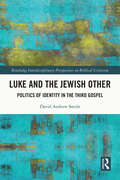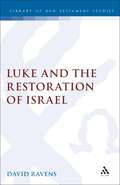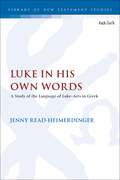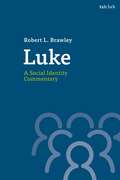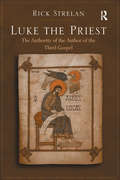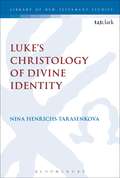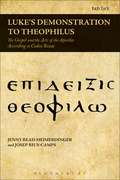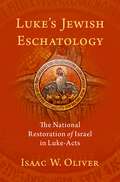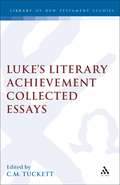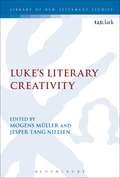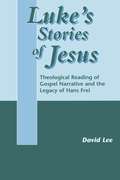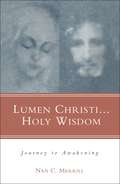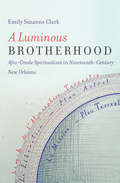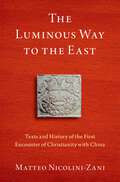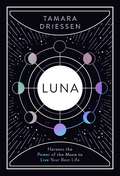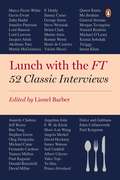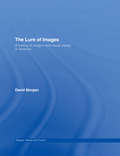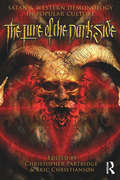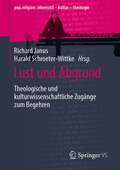- Table View
- List View
Luke and the Jewish Other: Politics of Identity in the Third Gospel (Routledge Interdisciplinary Perspectives on Biblical Criticism)
by David Andrew SmithLuke and the Jewish Other takes up the debated question of the orientation of Luke towards the Jewish people. Building on recent studies in the social history of early Jewish-Christian relations, it offers an analysis of Luke’s portrayal of Jewish and Christian identities that challenges the common assumption that the construction of religious identity in antiquity necessarily depended upon antagonistic relations with others. Taking account of the deep and often divisive difference that belief in Jesus made in Luke’s community, the author argues that Luke hoped to bring about both a rapprochement with and the conversion of contemporary Jews. Through this account of identity and alterity in the Gospel of Luke, the book cuts across boundaries of biblical studies, history, theology, and social theory, proposing a way forward for the study of Luke’s relation to Judaism and of the "parting of the ways" between Jews and Christians in the early Common Era.
Luke and the Restoration of Israel (The Library of New Testament Studies #119)
by David RavensRavens argues that Luke's belief in God's restoration of Israel provides the key context for understanding Luke-Acts. His attitudes to Jews, his surveys of Israel's history and his interest in the Samaritans combine to suggest his wider, pre-Davidic, view of Israel-a view that becomes the pattern for the restored Israel under its Davidic king. Luke's belief leads him to present Christology and atonement in ways that cohere with Jewish hopes and to correct apparently anti-Jewish elements in Paul's letters and Matthew's Gospel. This theme also determines his account of the gentile mission and his pastoral concern for unity.
Luke in His Own Words: A Study of the Language of Luke–Acts in Greek (The Library of New Testament Studies)
by Jenny Read-HeimerdingerJenny Read-Heimerdinger examines the language of Luke-Acts, exploring aspects of Luke's use of Greek that traditional approaches have not generally accounted for previously. Drawing on contemporary developments in linguistics - broadly referred to as 'discourse analysis' - Read-Heimerdinger emphasises that paying close attention to the context of language is vital to understanding the reasons behind an author's choices.Read-Heimerdinger applies the tools of discourse analysis to several features of Luke's Greek - such as variation in word order, the use of the article and fine distinctions between synonyms - in order to demonstrate how principles that govern their use subsequently affect exegesis. In addition, she makes suggestions to account for manuscript variation, which in turn have an impact on the editorial choices of Nestle-Aland's Greek New Testament.
Luke in His Own Words: A Study of the Language of Luke–Acts in Greek (The Library of New Testament Studies)
by Jenny Read-HeimerdingerJenny Read-Heimerdinger examines the language of Luke-Acts, exploring aspects of Luke's use of Greek that traditional approaches have not generally accounted for previously. Drawing on contemporary developments in linguistics - broadly referred to as 'discourse analysis' - Read-Heimerdinger emphasises that paying close attention to the context of language is vital to understanding the reasons behind an author's choices.Read-Heimerdinger applies the tools of discourse analysis to several features of Luke's Greek - such as variation in word order, the use of the article and fine distinctions between synonyms - in order to demonstrate how principles that govern their use subsequently affect exegesis. In addition, she makes suggestions to account for manuscript variation, which in turn have an impact on the editorial choices of Nestle-Aland's Greek New Testament.
Luke: A Social Identity Commentary (T&T Clark Social Identity Commentaries on the New Testament)
by Robert L. BrawleyIn this commentary, Robert L. Brawley provides comprehensive coverage of issues and concerns related to Luke from the perspective of social identity. He argues that the Gospel of Luke is strongly concerned with the formation of identity from the very start of the text, which aims at the creation of a socially responsible community in continuity with that community's collective past.Brawley establishes a theoretical framework that focuses his interpretation - ranging from the narrative world and sociological issues to postcolonialism and hierarchies of dominance - and uses these perspectives to provide a clear overview of historical and critical issues related to an understanding of Luke. He then provides a thorough outline of and commentary on the text of the Gospel. Brawley's engagement with the text serves as an invaluable resource for scholars, students, clergy, and others interested in their own discoveries of the resources of Luke.
Luke the Priest: The Authority of the Author of the Third Gospel
by Rick StrelanThis book focuses on the authority and status of the author of Luke-Acts. What authority did he have to write a Gospel, to interpret the Jewish Scriptures and traditions of Israel, to interpret the Jesus traditions, and to update the narrative with a second volume with its interpretation of Paul and the other apostles who appear in the Acts narrative? Rick Strelan constructs the author as a Jewish Priest, examining such issues as writing and orality, authority and tradition, and the status and role of priests. The analysis is set within the context of scholarly opinion about the author, the intended audience and other related issues.
Luke the Priest: The Authority of the Author of the Third Gospel
by Rick StrelanThis book focuses on the authority and status of the author of Luke-Acts. What authority did he have to write a Gospel, to interpret the Jewish Scriptures and traditions of Israel, to interpret the Jesus traditions, and to update the narrative with a second volume with its interpretation of Paul and the other apostles who appear in the Acts narrative? Rick Strelan constructs the author as a Jewish Priest, examining such issues as writing and orality, authority and tradition, and the status and role of priests. The analysis is set within the context of scholarly opinion about the author, the intended audience and other related issues.
Luke’s Christology of Divine Identity (The Library of New Testament Studies #542)
by Nina Henrichs-TarasenkovaHenrichs-Tarasenkova argues against a long tradition of scholars about how best to represent Luke's Christology. When read against the backdrop of ancient ways of constructing personal identity, key texts in the Lukan narrative demonstrate that Luke indirectly characterizes Jesus as the one God of Israel together with YHWH. Henrichs-Tarasenkova employs a narrative approach that takes into consideration recent studies of narrative and history and enables her to construct characters of YHWH and Jesus within the Lukan narrative. She employs Richard Bauckham's concept of divine identity that she evaluates against her study of how one might speak of personal identity in the Greco-Roman world. She engages in close reading of key texts to demonstrate how Luke speaks of YHWH as God in order to demonstrate that Luke-Acts upholds a traditional Jewish view that only the God of Israel is the one living God and to eliminate false expectations for how Luke should speak of Jesus as God.This analysis establishes how Luke binds Jesus' identity to the divine identity of YHWH and concludes that the Lukan narrative, in fact, does portray Jesus as God when it shows that Jesus shares YHWH's divine identity.
Luke's Demonstration to Theophilus: The Gospel and the Acts of the Apostles According to Codex Bezae
by Jenny Read-Heimerdinger Josep Rius-CampsThis is the first complete English translation of Luke's Demonstration to Theophilus (the books of Luke and Acts) as found in Codex Bezae. Codex Bezae is a bilingual 4th century Greek-Latin manuscript. In the past it has been viewed as a marginal manuscript witness. However, the pioneering work of Jenny Read-Heimerdinger and Josep Rius-Camps (The Message of Acts in Codex Bezae 4 vols, published by T&T Clark) has brought the variant readings in this fascinating document to the fore. Their work reveals that, far from being a late revision, Codex Bezae can be seen as one of the oldest versions of Luke's work in existence. This book presents the two texts unified in one volume, as Luke intended them, for the first time in any published edition. After an introduction explaining the importance of the Bezan text, as well as providing obeservations about its variances from other manuscripts a meticulous and continuous Greek transcript is presented together with the English translation on facing pages. This will prove an indespensible reference tool for scholars of Luke-Acts.
Luke's Jewish Eschatology: The National Restoration of Israel in Luke-Acts
by Isaac W. OliverLuke, the eponymous author of the gospel that bears his name as well as the book of Acts, wrote the largest portion of the New Testament. Luke is generally thought to be a gentile. This book addresses a question raised by Jesus's disciples at the very beginning of Acts: "Lord, will you at this time restore the kingdom to Israel?" The question is freighted with political and national significance as it inquires about the restoration of political sovereignty to the Jewish people. This book investigates Luke's perspective on the salvation of Israel in light of Jewish restoration eschatology. It situates Luke-Acts in the aftermath of the destruction of the Second Temple in 70 CE. The author of Luke-Acts did not write the Jews off but still awaited the restoration of Israel. Luke conceived of Israel's eschatological restoration in traditional Jewish terms. The nation of Israel would experience liberation in the fullest sense, including national and political restoration. Luke's Jewish Eschatology builds upon the appreciation of the Jewish character of early Christianity in the decades after the Holocaust, which has witnessed the reclamation of the Jewishness of the historical Jesus and even Paul.
Luke's Jewish Eschatology: The National Restoration of Israel in Luke-Acts
by Isaac W. OliverLuke, the eponymous author of the gospel that bears his name as well as the book of Acts, wrote the largest portion of the New Testament. Luke is generally thought to be a gentile. This book addresses a question raised by Jesus's disciples at the very beginning of Acts: "Lord, will you at this time restore the kingdom to Israel?" The question is freighted with political and national significance as it inquires about the restoration of political sovereignty to the Jewish people. This book investigates Luke's perspective on the salvation of Israel in light of Jewish restoration eschatology. It situates Luke-Acts in the aftermath of the destruction of the Second Temple in 70 CE. The author of Luke-Acts did not write the Jews off but still awaited the restoration of Israel. Luke conceived of Israel's eschatological restoration in traditional Jewish terms. The nation of Israel would experience liberation in the fullest sense, including national and political restoration. Luke's Jewish Eschatology builds upon the appreciation of the Jewish character of early Christianity in the decades after the Holocaust, which has witnessed the reclamation of the Jewishness of the historical Jesus and even Paul.
Luke's Literary Achievement: Collected Essays (The Library of New Testament Studies #116)
by Christopher M. TuckettThe essays in this collection come from a research symposium involving the universities of Manchester and Lausanne. The essays cover a wide range of mutually-enriching approaches to the study of the Lukan writings. Aspects considered include Luke's use of the term 'Son of Man', his use of scripture, his literary achievements, and the issue of 'godfearers' in Acts.
Luke's Literary Creativity (The Library of New Testament Studies)
by Mogens Müller Jesper Tang NielsenA combination of two classic discussions in New Testament scholarship, the contributions in this volume shed light on the still unsolved synoptic problem by using the well-coined concept of rewriting to describe the relationship between the synoptic gospels. The contributions work with the hypothesis that the synoptic tradition can be conceived of as a process of rewriting: Matthew rewrote Mark and Luke rewrote Mark and Matthew. This approach to the synoptic problem dismantles the grounds for the otherwise widely accepted two-source theory. If it can be shown that Luke knew Matthew's Gospel the Q-hypothesis is superfluous. One group of articles focuses on the general question of Luke's literary relation to the other gospels. In these essays, the concept of rewriting describes Luke's use of his sources. The second part of the collection examines a number of texts in order to shown how Luke rewrites specific passages. In the final section the contributions concern Luke's relation to Roman authorities. It is shown that Luke's literary creativity is not limited to his predecessors in the gospel tradition. Rewriting is his literary strategy.
Luke's Stories of Jesus: Theological Reading of Gospel Narrative and the Legacy of Hans Frei (The Library of New Testament Studies #185)
by David LeeThe current interest in reading the Gospels as narratives has reclaimed aspects of these texts that historical-critical approaches failed to respect. The richness of these newer readings can, however, disguise their limitations as literary-critical exercises. Developing Hans Frei's concern for theological reading, David Lee reworks the narratology of the Dutch literary theorist Mieke Bal to produce a theological narrative reading practice that formally respects the text as scripture while leaving open the possible meanings that readers may construct for themselves in the act of reading. Lee demonstrates his approach through readings of the Narrator and the characters Jesus and the Demons as aspects of a composite Lukan narrative Christology.
Lumen Christi...Holy Wisdom: Journey to Awakening
by Nan C. MerrillThis inspiring book contains admonitions, challenges, and encouragements for the reader to move up another step on the spiritual ladder. In short, these are spiritual self-help exercises for personal improvement.The gentle hints and suggestions come in the form of meditations and brief contemplative insights, which will help the hesitant inquirer who is making the first gestures towards inner contentment.
A Luminous Brotherhood: Afro-Creole Spiritualism in Nineteenth-Century New Orleans
by Emily Suzanne ClarkIn the midst of a nineteenth-century boom in spiritual experimentation, the Cercle Harmonique, a remarkable group of African-descended men, practiced Spiritualism in heavily Catholic New Orleans from just before the Civil War to the end of Reconstruction. In this first comprehensive history of the Cercle, Emily Suzanne Clark illuminates how highly diverse religious practices wind in significant ways through American life, culture, and history. Clark shows that the beliefs and practices of Spiritualism helped Afro-Creoles mediate the political and social changes in New Orleans, as free blacks suffered increasingly restrictive laws and then met with violent resistance to suffrage and racial equality. Drawing on fascinating records of actual seance practices, the lives of the mediums, and larger citywide and national contexts, Clark reveals how the messages that the Cercle received from the spirit world offered its members rich religious experiences as well as a forum for political activism inspired by republican ideals. Messages from departed souls including Francois Rabelais, Abraham Lincoln, John Brown, Robert E. Lee, Emanuel Swedenborg, and even Confucius discussed government structures, the moral progress of humanity, and equality. The Afro-Creole Spiritualists were encouraged to continue struggling for justice in a new world where "bright" spirits would replace raced bodies.
The Luminous Way to the East: Texts and History of the First Encounter of Christianity with China (AAR Religion in Translation)
by Matteo Nicolini-ZaniThe Luminous Way to the East offers a comprehensive survey of the historical, literary, epigraphic, and archaeological sources of the first stage of the Christian mission to China. It explores the complex and multifaceted process of the interaction with the different cultural and religious milieux that the Church of the East experienced in its diffusion throughout Central Asia and into China during the first millennium. Matteo Nicolini-Zani provides an overview of the Christian presence in China during the Tang dynasty (618-907) by reconstructing the composition and organization of Christian communities, the geographical location of Christian monasteries, and the related historical events attested by the sources. Through a new and richly annotated English translation of the Chinese Christian texts produced in Tang China, the volume provides a documented look at what was the earliest, and perhaps the most extraordinary, encounter of Christianity with Chinese culture and religions (Confucianism, Daoism, and Buddhism). It shows how East Syriac Christianity in its eastward expansion along the Silk Road from Persia to China was open to the adoption of other languages and imagery and was able to enculturate the Christian teaching into new cultural and religious forms without losing its identity.
The Luminous Way to the East: Texts and History of the First Encounter of Christianity with China (AAR Religion in Translation)
by Matteo Nicolini-ZaniThe Luminous Way to the East offers a comprehensive survey of the historical, literary, epigraphic, and archaeological sources of the first stage of the Christian mission to China. It explores the complex and multifaceted process of the interaction with the different cultural and religious milieux that the Church of the East experienced in its diffusion throughout Central Asia and into China during the first millennium. Matteo Nicolini-Zani provides an overview of the Christian presence in China during the Tang dynasty (618-907) by reconstructing the composition and organization of Christian communities, the geographical location of Christian monasteries, and the related historical events attested by the sources. Through a new and richly annotated English translation of the Chinese Christian texts produced in Tang China, the volume provides a documented look at what was the earliest, and perhaps the most extraordinary, encounter of Christianity with Chinese culture and religions (Confucianism, Daoism, and Buddhism). It shows how East Syriac Christianity in its eastward expansion along the Silk Road from Persia to China was open to the adoption of other languages and imagery and was able to enculturate the Christian teaching into new cultural and religious forms without losing its identity.
Luna: Harness the Power of the Moon to Live Your Best Life
by Tamara DriessenFrom the author of The Crystal Code, comes Luna - the positive catalyst for change that we all need.Luna is your essential guide to harnessing the moon's healing potential and achieving a happier, more fulfilling life. Tamara Driessen is guaranteed to help you to realise your potential, turn challenges into transformative opportunities and become more connected with yourself. Luna empowers by grounding you in the moment, inspiring you to celebrate the positives in your life and helping you find a clear sense of purpose.Luna nourishes you with moon rituals for every occasion, from crystals to tarot and meditation, that you can use during the moon's cycles. Tamara guides you through New Moon Rituals to inspire new beginnings and positive life change, Waxing Moon Rituals to help you take action and achieve personal goals, Waning Moon Rituals to help you shed self-limiting beliefs, and Full Moon Rituals to promote abundance and help you thrive in life.By aligning yourself with the lunar phases and developing a deeper connection with the moon, you'll gain balance and clarity, master the art of self-care and develop a true sense of what you want. Set your intentions with Luna, awaken your intuition and discover the potential that comes with living by the moon's mystic cycles.What can you do today to change your life? Let Tamara Driessen show you.
Lunch with the FT: 52 Classic Interviews
by Lionel BarberFrom the very first mouthful, 'Lunch with the FT' was destined to become a permanent fixture in the Financial Times.One thousand lunches later, the FT's weekly interview has become an institution. From film stars to politicians, tycoons to writers, dissidents to lifestyle gurus, the list reads like an international Who's Who of our times. Lunch with the FT is a selection of the best: 52 classic interviews conducted in the unforgiving proximity of a restaurant table. From Angela Merkel to Sean 'P. Diddy' Combs, Martin Amis to one of the Arab world's most notorious sons, this book brings you right to the table to decide what you think of or world's most powerful players.
The Lure of Images: A history of religion and visual media in America
by David MorganThis is the history of the relationship between mass produced visual media and religion in the United States. It is a journey from the 1780s to the present - from early evangelical tracts to teenage witches and televangelists, and from illustrated books to contemporary cinema. David Morgan explores the cultural marketplace of public representation, showing how American religionists have made special use of visual media to instruct the public, to practice devotion and ritual, and to form children and converts. Examples include:studying Jesus as an American idolJewish kitchens and Christian ParlorsBilly Sunday and Buffy the Vampire SlayerUncle Tom’s Cabin and the anti-slavery movement. This unique perspective reveals the importance of visual media to the construction and practice of sectarian and national community in a nation of immigrants old and new, and the tensions between the assimilation and the preservation of ethnic and racial identities. As well as the contribution of visual media to the religious life of Christians and Jews, Morgan shows how images have informed the perceptions and practices of other religions in America, including New Age, Buddhist and Hindu spirituality, and Mormonism, Native American Religions and the Occult.
The Lure of Images: A history of religion and visual media in America (Media, Religion And Culture Ser.)
by David MorganThis is the history of the relationship between mass produced visual media and religion in the United States. It is a journey from the 1780s to the present - from early evangelical tracts to teenage witches and televangelists, and from illustrated books to contemporary cinema. David Morgan explores the cultural marketplace of public representation, showing how American religionists have made special use of visual media to instruct the public, to practice devotion and ritual, and to form children and converts. Examples include:studying Jesus as an American idolJewish kitchens and Christian ParlorsBilly Sunday and Buffy the Vampire SlayerUncle Tom’s Cabin and the anti-slavery movement. This unique perspective reveals the importance of visual media to the construction and practice of sectarian and national community in a nation of immigrants old and new, and the tensions between the assimilation and the preservation of ethnic and racial identities. As well as the contribution of visual media to the religious life of Christians and Jews, Morgan shows how images have informed the perceptions and practices of other religions in America, including New Age, Buddhist and Hindu spirituality, and Mormonism, Native American Religions and the Occult.
The Lure of the Dark Side: Satan and Western Demonology in Popular Culture
by Christopher H. Partridge Eric S. ChristiansonDemons, devils, spirits and vampires are present throughout popular Western culture in film, music and literature. Their religious significance has only recently begun to be explored. 'The Lure of the Darkside' brings together the work of some of the most important and creative scholars in the field of Biblical and Religious Studies. The essays explore demonology in popular culture from a range of perspectives: Satanism within contemporary music; the relationship between hymn and horror film; the career of Hannibal Lecter; the portrayal of Satan in films about Christ; and spiritual perversion in the Harry Potter Stories. This fresh and ground-breaking volume will be of interest to students of religious studies and theology, as well as literary and popular culture.
The Lure of the Dark Side: Satan and Western Demonology in Popular Culture
by Christopher H. Partridge Eric S. ChristiansonDemons, devils, spirits and vampires are present throughout popular Western culture in film, music and literature. Their religious significance has only recently begun to be explored. 'The Lure of the Darkside' brings together the work of some of the most important and creative scholars in the field of Biblical and Religious Studies. The essays explore demonology in popular culture from a range of perspectives: Satanism within contemporary music; the relationship between hymn and horror film; the career of Hannibal Lecter; the portrayal of Satan in films about Christ; and spiritual perversion in the Harry Potter Stories. This fresh and ground-breaking volume will be of interest to students of religious studies and theology, as well as literary and popular culture.
Lust und Abgrund: Theologische und kulturwissenschaftliche Zugänge zum Begehren (pop.religion: lebensstil – kultur – theologie)
by Richard Janus Harald Schroeter-WittkeDas Buch beleuchtet die Komplexe Lust, Begehren und Abgrund in popkulturellen Darstellungen aus theologischer und kulturwissenschaftlicher Perspektive.
